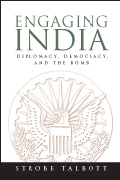On May 11, 1998, three nuclear devices detonated under the Thar Desert in India shook the surrounding villages—and the rest of the world. The immediate effect was to plunge U.S.-India relations, already vexed by decades of tension and estrangement, into a new crisis. The situation deteriorated further when Pakistan responded in kind two weeks later, testing a nuclear weapon for the first time. Engaging India is the firsthand story of the diplomacy conducted between the United States and the two South Asian neighbors after the nuclear tests. In this book, the American point man for the dialogue takes us behind the scenes of one of the most suspenseful and consequential diplomatic dramas of our time, reconstructing what happened—and why—with narrative verve, rich human detail, and penetrating analysis. From June 1998 to September 2000, in what was the most extensive dialogue ever between the United States and India, Deputy Secretary of State Strobe Talbott and Indian Minister of External Affairs Jaswant Singh met fourteen times in seven countries on three continents. They discussed both the immediate items on the security and nonproliferation agenda, as well as their wider visions for the U.S.-India relationship and the potential for economic and strategic cooperation between the two countries. As the relationship improved over the course of the talks, the United States was to able play a role in averting the possibility of nuclear war over the contested territory of Kashmir in the summer of 1999—the specifics of which are included for the first time in this book, told in way only a protagonist can. The Talbott-Singh diplomacy laid the groundwork for the transformational visit of President Bill Clinton to India in March 2000 and helped end fifty years of estrangement between the world’s two largest democracies. As pursuit of Islamic militants continues across South Asia, the increased cooperation established by Talbott and Singh will be an invaluable asset for current and future leaders of both countries. This book provides, for the first time, an insider’s perspective on the ground-breaking efforts to build a cordial relationship between the United States and India. The general reader will find it accessible, and more important, an indispensable tool for understanding America’s current role in South Asia, and the prospects for improved relations.

Book
Engaging India
Diplomacy, Democracy, and the Bomb
Release Date: August 5, 2004
On May 11, 1998, three nuclear devices detonated under the Thar Desert in India shook the surrounding villages—and the rest of the world. The immediate effect was to plunge U.S.-India...
Inside Look:

